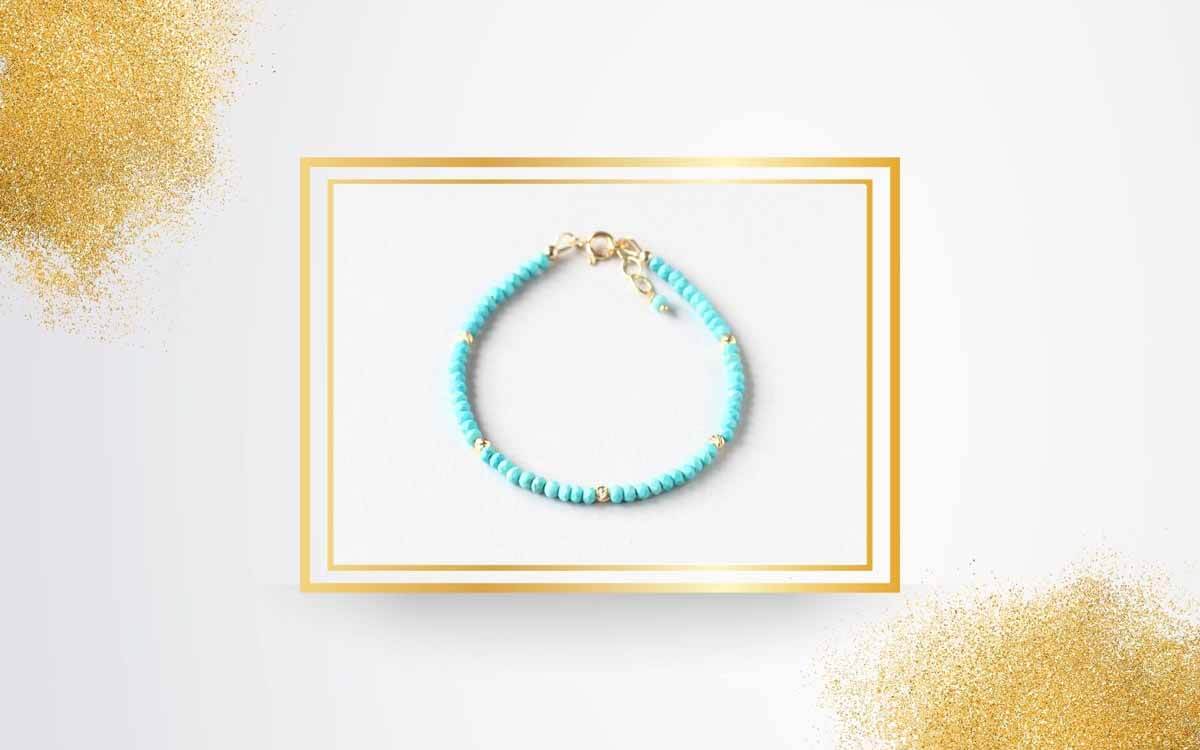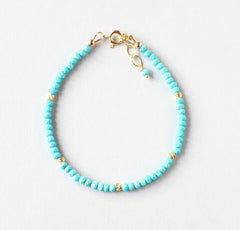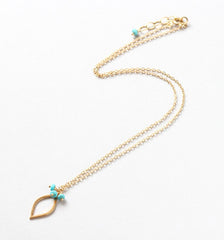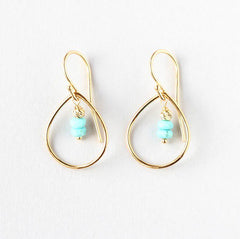
Turquoise - a Vibrant Summer Must-Have
Turquoise - a Vibrant Summer Must-Have
It is no secret that Turquoise is a favourite gemstone among many and a must-have for summer months. It has been admired for centuries for its striking blue-green hues and esteemed for its spiritual significance. Creating jewellery with this timeless beauty is our joy. In our collection, Turquoise is combined with gold vermeil for effortless sophistication and understated glamour. Turquoise is certainly more than just a pretty gemstone!
Did You Know?
1. Turquoise is the birthstone for December
2. Turquoise is a symbol of good luck and protection
3. “Robin egg” blue colour is the most praised
4. Turquoise is one of the earliest known gemstones
5. Turquoise is soft and porous and requires good care
Formation of Turquoise
The formation process of Turquoise is quite fascinating. Over millions of years, weathering and erosion break down copper-rich rocks. This dissolved copper then interacts with aluminium-rich phosphate solutions, eventually precipitating and crystallising within cracks, fissures and cavities in host rocks like sandstone or basalt. This process creates the mesmerising veins and lumps of Turquoise we treasure today.
The vibrant colours of Turquoise, ranging from sky blue to deep green, are attributed to the presence of copper and iron impurities, as well as varying degrees of hydration. Its distinctive web-like patterns, known as matrix, further enhance its visual appeal and authenticity.
The best quality Turquoise comes from Northeast Iran. Turquoise deposits are also found in Afghanistan, Argentina, Australia, Brazil, China, Israel, Mexico, Tanzania and the USA.
The word Turquoise comes from the French expression “Pierre Turque” meaning "Turkish stone". The mineral was first brought to Europe in the 13th century from Turkey via the Silk Road from the mines in Iran.
Healing Properties and Benefits of Turquoise
Turquoise is admired as a stone of protection, wisdom and spiritual harmony. The stone is also believed to dispel negative energies and promote inner tranquillity and emotional balance. Turquoise is a talisman of luck and fortune. It is thought to attract abundance and prosperity to those who wear it with respect and gratitude. The calming blue hues evoke feelings of serenity and inner peace.
Symbolism and Cultural Significance of Turquoise
Across diverse cultures and civilisations, Turquoise held profound symbolic meanings. Civilisations such as the Egyptians, Persians, Native Americans and Aztecs incorporated Turquoise into their art, jewellery and religious ceremonies. From adorning the tombs of pharaohs to gracing the crowns of kings and queens, Turquoise held a sacred place in the hearts of those who sought its protective and healing properties.
For ancient Egyptians, Turquoise symbolised protection, rebirth, and good fortune. They adorned themselves with Turquoise talismans and incorporated it into funerary masks, believing it would guide the deceased into the afterlife. They called turquoise mefkat, which meant “joy” and “delight.”
For Native Americans, Turquoise represented wisdom, communication, sky and water. It was used in ceremonies and rituals, and crafted into jewellery for protection, healing and strengthening one's spirit.
In Persian culture, Turquoise symbolised victory, success and heaven. Persian warriors often wore Turquoise amulets for courage and protection in battles. Persians adorned their daggers and horses’ reins with it. Their name for turquoise, pirouzeh, meant “victory.”
Tibetans saw it as a symbol of spiritual connection and protection from harm. Turquoise was used in prayer beads and decorative objects.
Even today, Turquoise continues to be a popular gemstone, valued for its beauty and symbolic meaning.
Myths and Legends of Turquoise
Throughout history, Turquoise has been a part of many myths and legends that speak to its mystical beauty. They highlight the deep connection various cultures have felt with Turquoise, associating it with the divine, natural world and beauty surrounding us.
In Native American folklore, Turquoise is often regarded as a gift from the gods, bestowed upon humanity as a symbol of protection and spiritual guidance. According to Navajo legend, Turquoise is the fallen sky stone, a fragment of the heavens that landed on Earth to bless mankind with its celestial essence.
In Egypt, Thoth, the god of wisdom, used Turquoise to mend the sky, creating the brilliant blue we see today. Turquoise was then seen as a fragment of the celestial realm.
Turquoise Jewellery Care
Turquoise is a relatively delicate gemstone, so proper care is essential to maintain its beauty and longevity.
To prevent damage and discolouration, it is advisable to avoid exposing Turquoise jewellery to harsh chemicals, extreme temperatures and prolonged sunlight.
When cleaning Turquoise, a soft cloth dampened with mild soap and water is sufficient to remove dirt and debris without causing harm to the stone.
Storing Turquoise jewellery in a soft pouch or jewellery box away from other gemstones can help prevent scratches and abrasions.
Conclusion
As we honour the ancient traditions and timeless wisdom associated with Turquoise, let us embrace its transformative power and celebrate the profound beauty of this beloved gemstone. In its tranquil depths, we discover not only the mysteries of the Earth but also the eternal essence of the human soul. Turquoise transcends its physical form to represent the timeless spirit of healing, protection and spiritual awakening. Wearing Turquoise jewellery takes us on a journey inward to the immense wisdom of the universe.
Browse Our Turquoise Jewellery
References:







